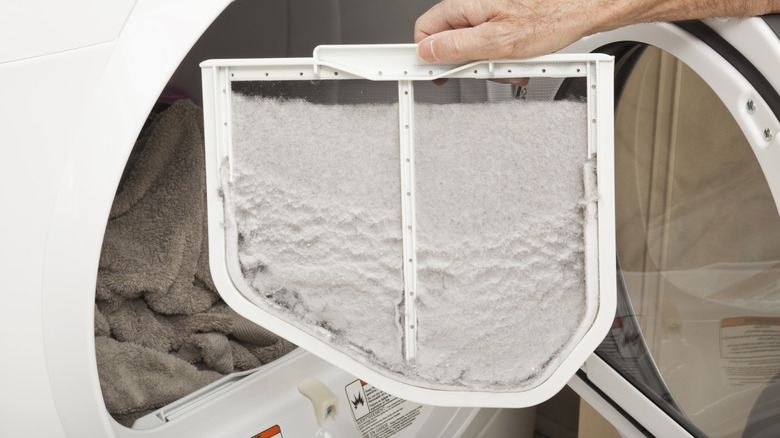Save Your Dryer Lint To Help Combat Weeds In The Garden. Here's How
You are probably accustomed to tossing lint straight into the garbage after you remove it from your dryer. Of course, it's great to keep up with cleaning out your dryer vent between uses, but you might not want to be so quick to dispose of it right away. Did you know that you can actually reuse dryer lint around the home? This is an easy way to reduce waste. More specifically, dryer lint can be used to keep weeds from taking over your garden.
A layer of lint over your garden's soil acts as a protective barrier that prevents weeds from growing, according to some gardening hack enthusiasts who have had success with this method. However, keep in mind that this trick's effectiveness is proven by mostly anecdotal evidence. Still, it may be worth trying out this more affordable, environmentally-friendly alternative to other weed prevention methods. With this convenient weed fighter already in your home, get ready to say goodbye to backbreaking weed-pulling sessions and harsh weed-killing chemicals. The next time you collect lint from your dryer vent, consider keeping it in a jar or plastic storage bag so that you can use it on your garden.
How to use lint to prevent weeds from growing
To use lint to protect your garden, start by getting rid of any weeds that are already in your soil. Next, distribute a thin layer of lint over the soil in your garden. Be sure to avoid getting it onto your plants, fruits, or vegetables. Simply layer the lint around the bottom of your plants instead. Consider adding a layer of mulch on top if you are not a fan of the way the lint looks in your garden. Mulch will also help everything remain in place during high wind days. Most dryer lint is biodegradable, so it will break down into the soil over time. You do not have to worry about it washing away and ending up down a drain or in a landfill where it will remain forever.
Lint's biodegradability is great for the environment, but it also means that you will need to periodically check up on the sections of your garden where you applied the material. Eventually, you will need to reapply it. Rainstorms can also break lint down and decrease its effectiveness, so do not forget to apply more lint to your garden after it rains. As previously mentioned, it might be helpful to continuously collect your dryer lint in a container so that you always have enough on hand when it is time to redistribute it across your soil.
How lint prevents weeds
You might be wondering how exactly lint prevents common garden weeds from sprouting. The material works similarly to mulch by acting as a barrier between weed seeds and soil. This way, the seeds are never able to root themselves in your garden. Just like mulch, lint also blocks weeds that have already landed in your soil from getting enough sunlight to continue growing. This means that the lint can work as a defense against both new weeds and weed seeds that have already landed in your soil. Along with protecting your garden against weeds, lint can also be used in compost. It acts as a carbon source that provides your soil with nutrients, energy, excess moisture absorption, and more. This means that the material can help your soil remain healthy as it breaks down over time.
Before using lint to protect your garden, there are a couple things to keep in mind. First, evaluate whether you use dryer sheets or any other substances that may contain chemicals that are harmful for your plants in your laundry. If so, your lint should not be used in your garden. You can simply use wool dryer balls instead of scented dryer sheets to ensure your lint will not pose harm. Secondly, if your clothes are made of synthetic fibers, those won't break down in you garden. The best lint to use is from natural fabrics like cotton and wool.


